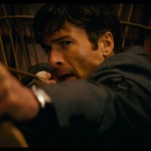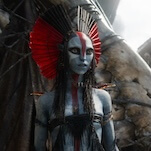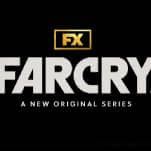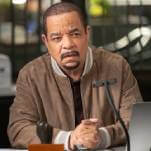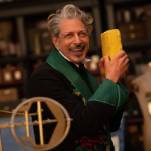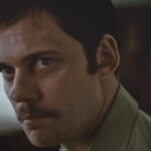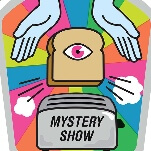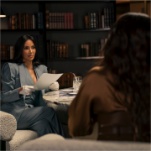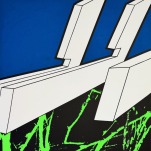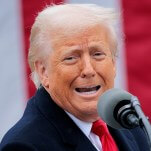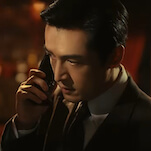For most of the history of television, the barrier to syndication—and to profitability—has been 100 episodes. The shows that have made it to that mark are an unusual group. Many were big hits. Some found small cult audiences. Still others just hung on as best they could and never posted numbers quite low enough to be canceled. In 100 Episodes, we examine the shows that made it to that number, considering both how they advanced and reflected the medium and what contributed to their popularity.
“It’s not violence, it’s action. Kids love action.”
—Denis Leary, Small Soldiers (1998)
The Untouchables, which ran from 1959 to 1963 on ABC, helped to redefine the TV crime drama by introducing thrills and action to the genre. Another interpretation came from Carl Perian—chief counsel to Thomas J. Dodd, chair of the 1961 Senate Subcommittee On Juvenile Delinquency, to investigate the effects of violence on television— who said, “We made films for each hearing. ABC complained that we took them out of context, so I said… ‘If they don’t want us showing excerpts, let’s show their own trailers.’ The next week, I ran 30 minutes of trailers for The Untouchables, and I swear to God, when it was over the room was shell-shocked. It was nothing but machine guns, bombings, and stabbings. We said, ‘All right, now what’s your complaint about showing excerpts?’”
There had been other crime dramas on TV, but the most significant of them, Dragnet, wasn’t an action show. It wasn’t even a rethinking of the long-running radio show so much as it was a TV broadcast of it, with slides. (Continents could form and break apart in the time it took Jack Webb to change expression.) And there were plenty of action shows, but most of them were Westerns. As a genre, the horse opera dominated TV drama well into the 1960s, falling into decline around the same time that Western movies began to die out. Set in Prohibition-era Chicago, The Untouchables had its own template in the gangster movies that first achieved popularity back when such stories counted as topical material. Like the Westerns, the show was set in a pre-Miranda, clear-cut moral universe, with pure-hearted but two-fisted heroes pitted against forces of pure evil. Its 1930s Chicago was as far removed from the concerns and realities of America in the late ’50s and early ’60s as Dodge City. But its tommy guns and vintage cars packed more of a punch than Gunsmoke’s six-shooters and chases on horseback.
When Desi Arnaz first suggested that there might be a TV series in the self-generated G-man legend of Eliot Ness, he met with a cold reception from network executives, who assumed that the gangster movie was a dead genre. What they failed to understand was that, thanks in large part to the second life television was starting to give to old movies, popular culture was entering a new period when scarcely anything ever fully went away and nothing ever died; old works and genres would be endlessly remade, rebooted, and recycled. The same year The Untouchables was first broadcast, Jean-Luc Godard was working on Breathless, in which the hero (Jean-Paul Belmondo) gazed at a movie poster image of his hero and sighed, “Bogie!” It was probably the first time that an actor in a movie had instantly connected with the audience by expressing their shared adoration of a movie star of a previous generation.
Arnaz brought in a lot of expertly chosen people to help him realize his ambition to “make the best damn television show on the air.” One person who became essential to the tone and appeal of the show was one of the most washed-up (and, arguably, one of the least talented) people on the set. That was Walter Winchell, once the feared and powerful king of gossipy, red-baiting tabloid journalism, who served as the series’ narrator. A decade earlier, Winchell had been the most popular personality on radio, but the advent of television was death to his career. Although he was given the chance to front a few of his own shows, they didn’t last long. The camera did not love him, and his breathless, rat-a-tat delivery made him seem like an anachronism. Arnaz told the network that Winchell was essential to his vision of the show because “Winchell is the period.” Judging from the show’s overall indifference to historical accuracy, he must have meant something different than authenticity. Winchell’s narration framed the show’s action in the style of the ’30s—not the best style that era had to offer, but the voice of yellow journalism at its most florid and hammy. Though he probably went to his grave without knowing it, Winchell’s staccato reading of such lines as “While prosperity stayed just around the corner for most of us, it came out and licked the hand of mobsters, bootleggers, and hoodlums” put the action in quotation marks without entirely undercutting it, lending it a faint tinge of camp. By sounding like a dinosaur in a fedora, he also made the show’s period seem as if it were much older and remote than it actually was.
The Untouchables began as a two-part installment of Westinghouse Desilu Playhouse, an anthology series from Desi Arnaz and Lucille Ball’s production company. (Another episode of that series, Rod Serling’s “The Time Element,” led, in a more indirect way, to the birth of another cult classic of the era, The Twilight Zone.) The pilot was written by Paul Monash, who later produced and adapted the 1973 movie The Friends Of Eddie Coyle. The director was Phil Karlson, a specialist in action movies who made such B-grade classics as Tight Spot, 5 Against The House, and The Phenix City Story, all from 1955. (B-movie directors didn’t get much of a break in those days.) The pilot aired, to spectacular ratings, in January 1959; by the time the series itself debuted 10 months later, the pilot had been released to movie theaters under the title The Scarface Mob. Desi Arnaz provided onscreen introductions to the TV broadcasts, and those who waited to see it in theaters missed out on one of the most entertaining moments of the original program, when Desi attempted to pronounce the word “autobiography.”
The Scarface Mob is an origin story that firmly establishes the template for the series. It’s 1930, and gangsterism has turned Chicago into a roaring den of vice and graft. Special agent Eliot Ness is sent in to clean the place up, a mission he hopes to execute by breaking up stills and speakeasies and busting heads. Knowing that most of the local law enforcement talent is on Scarface Al’s payroll, Ness painstakingly trawls through the country’s supply of manpower until he has assembled a task force of “six honest men,” the Untouchables, who can help him in his quest. The Feds are assisted by Joe Fuselli (Keenan Wynn), a reformed ex-con who possesses “the best pair of driving hands in Chicago,” and “speaks both Sicilian and Neapolitan dialects.” Joe’s seething contempt for the scum he and Ness have to deal with, combined with the vowel at the end of his name, make it clear that, whatever trouble he may once have gotten into in his Les Misérables youth, he is a representative of the majority of decent Italian-Americans who are disgusted by the false image that Alphonse Capone presents of their people. “Joe,” Ness tells him admiringly, “three guys like you would be an army.” “Nah,” says Joe modestly, holding up two fingers. “Two guys!”
Joe ends up getting whacked, and Ness proceeds directly to the second stage of grief and squats there. His way of staging a wake for his friend is to lead a raid on one of Capone’s warehouses, swinging an ax at the bolted doors. The axe bounces off, and Ness glowers at the doors and yells, “Steel!” He sounds as if he believes that this alloy was created for the express purpose of pissing him off, and there’s a second where it really looks as if he’s going to tear the doors off with his bare hands. Then he remembers that he has a gun and just shoots the lock off. Meanwhile, Capone (Neville Brand) is swanking around his posh apartment wearing a smoking jacket and chewing a cigar, savoring his hateful triumph. It isn’t until he looks out on the street below and sees that Joe’s funeral procession includes some of the trucks that haul his booze, that he realizes he may have overreached. Not long after, one of the bean counters from D.C. tells Ness that, while all the machine-gunning and raiding he and his Untouchables have been doing is just swell, there’s this new idea floating around the office that if they indict Capone for income-tax evasion, they may be able to actually put his scar-faced butt in prison. Ness shrugs and concedes that it’s worth a try. It makes for one anticlimactic ending—and, unlike Kevin Costner in the 1987 movie, Stack’s Ness doesn’t even get to take a break from the trail to throw somebody off a roof—but it is as close as the series ever got to historical accuracy.
Once the series got rolling, it settled into a string of gangster-of-the-week adventures, with Ness battling most of the best-remembered underworld celebrities of the time. The film critic David Thomson once referred to John Milius’ Dillinger (1973) as a “gangster board game,” a description that will do nicely for this show as well. In the first season alone, the Untouchables crossed paths with Bugs Moran (Lloyd Nolan), Mad Dog Coll (Clu Gulager), Dutch Schultz (Lawrence Dobkin), and Ma Barker, played by the Oscar-winning actress Clare Trevor. (The actual Ma Barker was just a hapless old woman with dubious taste in sons whose legend as a ruthless crime boss grew out of the FBI’s efforts to cover its ass after she was shot and killed by trigger-happy G-men. The Untouchables was not the place to go to hear revisionist takes on J. Edgar Hoover’s press releases.)
The special-guest hoods—in the first season, these included Martin Landau, Jack Weston, William Bendix, Alan Hale Jr., Darryl “Dobie Gillis” Hickman, Henry Silva, Cliff Robertson, Dan O’Herlihy, Anne Francis, Joe Mantell, Peter Falk, and Leslie Nielsen—were entrusted with the job of doing the flashy character acting that livened things up between the shootouts and the scenes in which trucks are used as battering rams. Many of the up-and-comers were clearly inspired by the example Neville Brand set in the pilot; Brand’s Capone often seemed to be revving up for a scene in which he’d get to turn into a werewolf, and was prone to tantrums, in which he would smash a water pitcher on the floor and bark, “And-a that’s-a what’s-a gonna a-happen-a to Mister Ness-a!” (The studio reportedly hired a dialect coach to work with Brand. They must have spent all their time watching Chico Marx movies.)
The most persistent of the show’s guest villains was Frank Nitti (Bruce Gordon), the Capone henchman who, in The Untouchables’ alternate-history universe, took charge of the Chicago mob while Big Al was at Alcatraz. (The real Nitti apparently had muscle even between his ears, and never rose above ceremonial-figurehead status. He got off easier on TV than he did in the movie, where he was the guy Costner threw off that roof.) Robert Stack later wrote that Bruce Gordon was “a tremendously versatile actor,” but that he became “so identified with the role [of Frank Nitti] that if he played Macbeth, people would expect him to end the play by sending the strong-arm boys after the witches with machine guns. It’s a prime example of how an actor can be so good in a particular role that it hinders rather than helps his career.” Stack doesn’t acknowledge it, but he might be writing a little bit about himself here.
Tall, handsome, and indomitable-looking—Ayn Rand was a big fan of his Eliot Ness—Robert Stack had shown some range and fire in his movie performances for Budd Boetticher (The Bullfighter And The Lady) and Douglas Sirk (The Tarnished Angels, Written On The Wind). He won an Emmy for playing Ness, but the role also left him unable to shake his image as an inflexible authority figure, an image that he perpetuated in later TV series and parodied in such movies as Airplane!, Beavis And Butt-head Do America, and Steven Spielberg’s 1941. In his autobiography, Stack wrote that “refusing the temptation to be flashy was not easy… but I decided that my character should be a counterpoint to all the gaudy pin-striped suits, bias-cut dresses, sexy broads, loud jazz, prostitutes, and machine guns. Ness would be played against the flamboyance of the villains.” Still, there was a difference between Stack’s stoic, seething Ness and Jack Webb’s robotic, asexual Joe Friday on Dragnet. Ness’ fires may have been banked, but they were still there. In one of the show’s standout episodes, the second-season premiere “The Rusty Heller Story,” a pre-Bewitched Elizabeth Montgomery plays a seductive moll with a Southern accent who’s looking for a sugar daddy to latch onto. She’ll settle for whichever gangster is on top, but she’d rather be with Ness, whom she calls “a very valuable hunk of yankee” and “a super boy scout.” Montgomery is hard to resist, and when Ness resists her, the disappointment runs both ways. He’s a hero, but that doesn’t mean he isn’t human.
An instant hit, The Untouchables was also an instant lightning rod for protestors. The violence was an issue, one that eventually inspired a congressional investigation. Looking at the violent scenes now, the surprise is that they’re still kind of surprising. People don’t stagger around with half their faces blown off or stalk through bloody gun battles naked with belts tied around their neck, the way they do now on cable shows, and the choreographed mayhem of The Untouchables doesn’t have the emotionally disturbing qualities of the work by directors like Sam Peckinpah and Arthur Penn that made movie violence a major issue in the later 1960s. But the show didn’t gingerly wade into its violence; episode after episode climaxes with sequences in which opposing armies—the Untouchables versus criminal gangs, one warring gang versus another—tear into each other with machine-gun fire, and stunt men assigned the job of dying on-camera throw themselves into it as if they’ve lived their whole lives waiting for the chance to clutch their chests and do a backward somersault and land face-down in a gutter. Internal memos obtained by congressional investigators detail a behind-the-scenes effort from the network and the producers to keep raising the ante. In one notorious memo, Quinn Martin, who oversaw production on the series from the pilot until its cancellation, complains to a writer that he’s getting tired of seeing characters run over by cars, because it’s been done so many times: “I like the idea of sadism, but I hope we can find another approach to it.”
The show also weathered attacks by Italian-American groups who, still smarting from the televised Kefauver hearings on organized crime, complained that the show dealt in anti-Italian stereotypes. (One Italian-American actually went to court over the show: Al Capone’s son Albert, who had gone to high school with Desi Arnaz, filed a lawsuit against Desilu, on the overly optimistic grounds that the show had defamed his father’s good name, just when people were prepared to remember Al Capone more for his soup kitchens and less for that whole business of beating people to death with baseball bats.) On this point, ABC caved: “Eventually,” Robert Stack writes, “we did stop using Italian names, switching to an unrecognizable nationality which would baffle a roomful of genealogists and send a Berlitz instructor scrambling for his dictionary.”
ABC also kept proudly pointing to Ness’ right-hand man, Enrico “Ricco” Rossi—played by the Greek-American actor Nick Georgiade, much as the Native American “Untouchable” Youngfellow was played by the Mexican-Yaqui Abel Fernandez, and the generically all-American Hobson was played by the Italian-American Paul Picerni. Unfortunately, whenever the show tried to pretend that one of the Untouchables working alongside Stack’s Ness had an identifiable personality of his own, it was like when one of the guys in Creedence Clearwater Revival who wasn’t John Fogerty tried to take lead. When the show was canceled, anti-violence groups claimed a victory. Although studies indicated that The Untouchables remained a favorite show of aspiring juvenile delinquents, its ratings had started to decline after the second season, when the producers first started trying to accommodate the pressure groups. It never stopped piling up bodies, but its confidence had been dented and its identity compromised.
Having solved the problem of violence on TV, the world moved on. Now officially defined as a TV star at a time when there was a clear dividing line between TV and movies, Robert Stack went on to be manly and authoritative in The Name Of The Game, Most Wanted, Strike Force, and the most successful and enduring of his post-Untouchables series, Unsolved Mysteries. A year after The Untouchables went on the air, Quinn Martin set up his own QM productions; once the show went off the air, he put out a steady stream of series—The Fugitive, The Invaders, Dan August, The F.B.I., Cannon, Barnaby Jones, The Streets Of San Francisco—that established him as perhaps the most successful crime/adventure producer of the late ’60s and ’70s.
After the 1987 movie showed the property still had some life in it, the series itself was revived as a syndicated program that ran for two seasons in the 1990s. This time, Al Capone was the principal villain throughout the series, and nobody seemed to regard any depiction of him as an ethnic slur, just a meaty role for a good character actor, in this case William Forsythe. (The same applies to Stephen Graham’s Capone on the current series Boardwalk Empire.) The real Eliot Ness—who recently turned up as a character in an episode of Supernatural—died in 1957, shortly before his autobiography, co-written with Oscar Fraley, was published. He died without receiving any hint that his name would outlive him in such spectacular fashion, but then, he didn’t really do most of the spectacular things that have been credited to him, including having anything to do with the tax-fraud plan that put Big Al behind bars. But it’s not his fault if the people who did bring Capone—and Frank Nitti, and Bugs Moran, and Mad Dog Coll, and so on—had no flair for self-promotion.
Next time: Homestarrunner.com

























